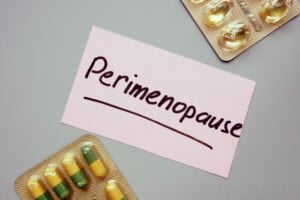Entering the realm of pre-menopause can be a transformative journey for women, marking the transition from reproductive years to a new phase of life. This transitional period, known as perimenopause, is characterized by a range of physical, emotional, and hormonal changes that can vary from woman to woman. In this blog, we will explore the various pre-menopause symptoms, shedding light on this often misunderstood stage of a woman’s life.
Contents
What Is “Pre-Menopause”?

Pre-menopause, also known as perimenopause, is a transitional stage in a woman’s reproductive life that occurs before the onset of menopause. Menopause is defined as the point in time when a woman has not had a menstrual period for 12 consecutive months, marking the end of her reproductive years. Pre-menopause precedes this final cessation of menstruation and involves a gradual transition marked by hormonal fluctuations and various physical and emotional changes.
Key Aspects of Pre-Menopause:
- Age Range: Pre-menopause typically begins in a woman’s late 30s to early 40s, although the age at which it starts can vary. It serves as a bridge between the reproductive years and the cessation of menstruation.
- Hormonal Changes: The primary hormonal changes during pre-menopause involve fluctuations in estrogen and progesterone levels. These hormones, which play crucial roles in the menstrual cycle and reproductive health, begin to decline as a woman approaches menopause.
Different Pre-Menopause Symptoms
Pre-menopause, also known as perimenopause, is the transitional phase leading up to menopause. During this time, women may experience a variety of symptoms as their bodies undergo hormonal changes. Here’s a description of pre-menopause symptoms:
Irregular Menstrual Cycles
Irregular menstrual cycles are a common and notable symptom during the pre-menopause phase, also known as perimenopause. This transitional period typically begins several years before menopause and is characterized by changes in hormonal levels. Here’s a closer look at irregular menstrual cycles as a pre-menopause symptom:
1. Length and Frequency:
- Menstrual cycles may become irregular in terms of both length and frequency.
- Cycles may be shorter or longer than usual, and the time between periods may vary.
2. Ovulation Changes:
- Ovulation, the release of an egg from the ovary, may become irregular or unpredictable.
- Some cycles may involve skipped ovulation, leading to changes in menstrual flow.
3. Menstrual Flow Variations:
- Changes in hormonal balance can affect the uterine lining, resulting in variations in menstrual flow.
- Periods may be heavier or lighter than usual, and the duration of bleeding may vary.
Hot Flashes and Night Sweats
Hot flashes and night sweats are common symptoms during the pre-menopause phase, known as perimenopause. These symptoms are typically associated with hormonal fluctuations, particularly the decline in estrogen levels. Here’s a closer look at how hot flashes and night sweats manifest as pre-menopause symptoms:
Hot Flashes:
- Onset in Perimenopause: Hot flashes often begin during perimenopause, signaling the start of hormonal changes in the body. They can occur irregularly and may intensify as a woman approaches menopause.
Night Sweats:
- Nocturnal Intensity: Night sweats, or episodes of excessive sweating during sleep, are a specific manifestation of hot flashes during the night They often end up waking up with drenched bedding and sleepwear.
Mood Swings and Emotional Changes

Mood swings and emotional changes are common symptoms experienced during the pre-menopause phase, also known as perimenopause. These changes are primarily attributed to hormonal fluctuations, particularly the decline in estrogen and, to some extent, progesterone. Here’s a detailed exploration of mood swings and emotional changes as pre-menopause symptoms:
1. Hormonal Influence:
- Estrogen plays a significant role in regulating neurotransmitters in the brain that affect mood and emotional well-being.
- The decline in estrogen levels during perimenopause can lead to imbalances in these neurotransmitters, contributing to mood swings.
2. Variability in Emotional States:
- Women in perimenopause may experience heightened emotional sensitivity and a range of emotions, including irritability, sadness, anxiety, and even euphoria.
- Emotional responses to situations may become more intense and unpredictable.
Vaginal Changes
Vaginal changes are common pre-menopause symptoms that occur during the perimenopausal phase. These changes are primarily associated with hormonal fluctuations, particularly the decline in estrogen levels. Here’s a detailed exploration of vaginal changes as pre-menopause symptoms:
1. Vaginal Dryness:
- Decreased estrogen levels can lead to a reduction in natural lubrication in the vagina.
- Vaginal dryness may cause discomfort, itching, and pain, especially during sexual activity.
2. Decreased Elasticity and Thinning of Vaginal Tissues:
- Estrogen helps maintain the elasticity and thickness of vaginal tissues.
- As estrogen levels decline, the vaginal walls may become thinner and less elastic, contributing to discomfort.
3. Changes in pH Balance:
- Estrogen plays a role in maintaining the acidic pH balance of the vagina, which helps prevent infections.
- With lower estrogen levels, the pH balance may change, increasing the risk of bacterial or fungal infections.
Changes in Libido
Changes in libido, or a woman’s sexual desire, can occur as pre-menopause symptoms during the perimenopausal phase. These changes are primarily influenced by hormonal fluctuations, particularly the decline in estrogen and, to some extent, testosterone levels. Here’s a closer look at how changes in libido manifest as pre-menopause symptoms:
1. Hormonal Influence:
- Estrogen plays a crucial role in maintaining healthy sexual function, including libido.
- During perimenopause, estrogen levels fluctuate and eventually decline, which can affect sexual desire.
2. Fluctuations in Testosterone:
- While testosterone is often associated with male sexual function, women also produce small amounts of testosterone that contribute to libido.
- Testosterone levels may decline during perimenopause, impacting sexual desire.
Sleep Disturbances

Sleep disturbances are common pre-menopause symptoms that often occur during the perimenopausal phase. These disturbances are primarily linked to hormonal fluctuations, particularly the decline in estrogen levels. Here’s an overview of sleep disturbances as pre-menopause symptoms:
1. Insomnia:
- Perimenopausal women may experience difficulty falling asleep, staying asleep, or both.
- Insomnia can be related to hormonal changes, night sweats, and psychological factors such as increased stress or anxiety.
2. Night Sweats:
- Hormonal fluctuations, particularly the decrease in estrogen, can lead to hot flashes and night sweats.
- Night sweats involve episodes of intense sweating during sleep, often leading to discomfort and sleep disruptions.
Weight Gain and Metabolic Changes
Weight gain and metabolic changes are common pre-menopause symptoms that can occur during the perimenopausal phase. These changes are often attributed to hormonal fluctuations, particularly the decline in estrogen levels. Here’s a closer look at weight gain and metabolic changes as pre-menopause symptoms:
1. Changes in Fat Distribution:
- Hormonal shifts, particularly the decrease in estrogen, can lead to changes in fat distribution.
- Women may notice an increase in abdominal fat, contributing to changes in body shape.
2. Metabolic Rate Changes:
- Estrogen plays a role in maintaining metabolic rate and energy balance.
- The decline in estrogen during perimenopause may contribute to a decrease in metabolic rate, making it easier to gain weight.
Bone Density Changes
Changes in bone density are important considerations during the pre-menopause phase, particularly in the perimenopausal period. These changes are linked to hormonal fluctuations, specifically the decline in estrogen levels. Here’s an exploration of bone density changes as pre-menopause symptoms:
1. Estrogen’s Role:
- Estrogen plays a crucial role in maintaining bone density by promoting the activity of osteoblasts (cells that build bone) and inhibiting osteoclasts (cells that break down bone).
- During perimenopause, estrogen levels gradually decline, impacting bone health.
2. Increased Risk of Osteoporosis:
- The decline in estrogen contributes to a reduction in bone density and an increased risk of osteoporosis.
- Osteoporosis is a condition characterized by weakened and brittle bones, making them more susceptible to fractures.
Memory and Cognitive Changes
Memory and cognitive changes are reported as symptoms during the perimenopausal phase, which is the transition period leading up to menopause. Hormonal fluctuations, especially the decline in estrogen, play a role in these cognitive changes. Here’s a closer look at memory and cognitive changes as pre-menopause symptoms:
1. Memory Lapses:
- Women in perimenopause may notice occasional memory lapses, such as forgetting names or misplacing objects.
- These lapses are often referred to as “menopausal moments” and are considered part of the cognitive changes.
2. Concentration Difficulties:
- Difficulty concentrating on tasks and staying focused may become more noticeable during perimenopause.
- Women may find it challenging to maintain attention, especially in multitasking situations.
Skin Changes

Skin and hair changes are common pre-menopause symptoms that can occur during the perimenopausal phase. These changes are primarily associated with hormonal fluctuations, particularly the decline in estrogen levels. Here’s a closer look at skin and hair changes as pre-menopause symptoms:
Skin Changes:
Decreased Collagen Production:
- Estrogen plays a role in promoting collagen production, which contributes to skin elasticity.
- Declining estrogen levels can lead to a reduction in collagen, resulting in decreased skin firmness and the formation of wrinkles.
Thinning and Drying of Skin:
- Changes in hormonal balance during perimenopause can contribute to skin thinning and dryness.
- The skin may feel less supple, and the appearance of fine lines and wrinkles may become more noticeable.
How To Manage Pre-Menopause Symptoms?
Managing pre-menopause symptoms involves a combination of lifestyle adjustments, self-care practices, and, in some cases, medical interventions. Here are some strategies to help manage pre-menopause symptoms:
1. Education and Awareness:
- Learn about the typical symptoms of pre-menopause to understand what to expect.
- Knowledge about the natural course of hormonal changes can help in coping with symptoms.
2. Healthy Diet:
- Maintain a well-balanced diet rich in fruits, vegetables, whole grains, and lean proteins.
- Ensure adequate intake of calcium and vitamin D for bone health.
- Limit caffeine, alcohol, and sugary foods, as they may exacerbate symptoms.
3. Regular Exercise:
- Engage in regular physical activity, including aerobic exercises and strength training.
- Exercise can help manage weight, alleviate mood swings, and promote overall well-being.
4. Stress Management:
- Practice stress-reduction techniques such as meditation, deep breathing exercises, or yoga.
- Adequate sleep, regular breaks, and relaxation techniques can contribute to stress management.
5. Quality Sleep:
- Establish a consistent sleep routine and ensure a comfortable sleep environment.
- Manage sleep disturbances with cooling techniques, such as fans or lightweight bedding.
Conclusion
In conclusion, pre-menopause is a transformative journey that brings about various changes in a woman’s life. By understanding and embracing these changes, women can navigate this phase with grace and empowerment. Open communication with healthcare providers, adopting healthy lifestyle habits, and building a strong support network are key elements in managing pre-menopause symptoms and promoting overall well-being.
As we demystify the pre-menopause experience, women can approach this phase with knowledge, resilience, and a sense of self-empowerment.
If you are facing menopause related issues, menopause treatment at HerMantra can help. Book your free trial online menopause treatment session now.


